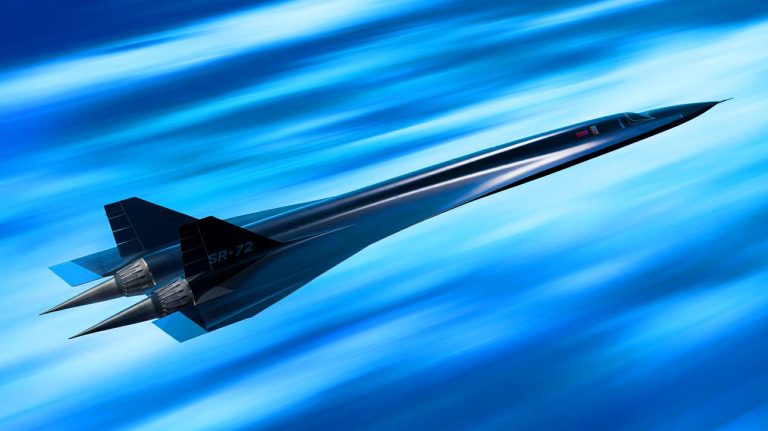| IN A NUTSHELL |
|
The development of the SR-72 hypersonic jet, known as the “Son of Blackbird,” is poised to revolutionize aerial reconnaissance and strike capabilities. This secretive project by Lockheed Martin Skunk Works, under the auspices of the United States Air Force, aims to introduce an unmanned aircraft that can exceed speeds of Mach 5. With its combination of speed, stealth, and advanced technology, the SR-72 is designed to overcome modern air defense systems and provide unparalleled intelligence-gathering capabilities. As the world anticipates its debut, questions about its strategic impact and technological innovations abound.
The Secretive SR-72 Program
The SR-72 project, shrouded in secrecy, is intended to be the hypersonic successor to the legendary SR-71 Blackbird. Developed by Lockheed Martin’s Skunk Works team, the SR-72 is expected to reach speeds over Mach 5, making it the fastest operational airframe ever built. Its purpose is to execute strategic intelligence, surveillance, and reconnaissance missions in environments that pose unacceptable risks to conventional manned platforms. The jet’s formidable speed and altitude capabilities are designed to penetrate advanced integrated air defense systems while delivering time-sensitive intelligence with minimal risk.
Unlike its predecessor, the SR-72 will be an unmanned, reusable aircraft, capable of autonomous missions at hypersonic speeds. With a length of over 100 feet, the SR-72 will echo the dimensions of the SR-71 but introduce a revolutionary propulsion system. The turbine-based combined cycle (TBCC) propulsion merges a traditional turbofan engine with a supersonic combustion ramjet, or scramjet, enabling sustained speeds above Mach 5. This dual-mode propulsion is essential, as no single engine can efficiently operate across the full subsonic-to-hypersonic flight envelope, marking a significant technological advancement.
Harnessing Hypersonic Speed
The SR-72’s hypersonic speed redefines strategic mobility, allowing it to traverse the continental United States to Europe or Asia in approximately 90 minutes. This rapid global reach enhances intelligence and strike capabilities, enabling commanders to make swift decisions in dynamic operational contexts. However, the program faces significant technical and financial hurdles. Although preliminary discussions with U.S. government stakeholders have occurred, securing full funding for a demonstrator airframe and engine development remains a challenge.
The SR-72’s path aligns with the USAF’s hypersonic roadmap, with a tentative in-service date by 2030. However, this timeline depends on overcoming propulsion, thermal management, and materials challenges inherent to sustained hypersonic flight. The aircraft’s high-speed profile is essential to counter modern air defense systems, such as the S-500 and HQ-19, by minimizing time-on-target and exposure windows. The TBCC configuration is not just a performance enhancement but a crucial operational necessity. The SR-72’s success could redefine power projection in denied-access environments through next-generation propulsion and uncrewed systems architecture.
Technological and Strategic Challenges
Developing the SR-72 involves overcoming immense technical hurdles, particularly in propulsion and thermal management. The hypersonic speeds required necessitate innovative solutions to manage the extreme heat generated during flight. The TBCC system, combining a turbofan and a scramjet, is pivotal to achieving these speeds. However, creating a reliable and efficient system that can transition seamlessly between subsonic and hypersonic speeds is a significant engineering challenge.
Financially, the SR-72 program must secure substantial investment to advance from prototype to operational status. While its alignment with the USAF’s hypersonic goals is promising, the costs associated with developing and deploying such advanced technology are considerable. The program’s success will depend on continued collaboration between government and industry to address these financial and technical obstacles. If successful, the SR-72 will mark a transformative milestone in aerial reconnaissance and strike capability, leveraging cutting-edge technology to maintain strategic superiority.
The Future of Hypersonic Aircraft
The SR-72 represents a significant leap forward in hypersonic technology, offering unprecedented speed and stealth capabilities. Its development underscores the growing importance of hypersonic aircraft in modern warfare, as nations seek to outpace and outmaneuver sophisticated air defense systems. The SR-72’s potential to serve as a platform for hypersonic strike weapons further enhances its strategic value, providing a crucial element in the United States’ military arsenal.
As the SR-72 program progresses, its impact on global military dynamics will be closely watched. The aircraft’s ability to deliver rapid intelligence and strike capabilities could shift the balance of power, prompting other nations to accelerate their hypersonic developments. The SR-72’s success will not only redefine aerial warfare but also set new standards for technological innovation and strategic planning. How will this hypersonic marvel reshape the future of global military engagements?
Did you like it? 4.5/5 (21)







Wow, Mach 5! That’s insanely fast! Can’t wait to see this in action. 🚀
Will this be used for commercial purposes, or strictly military?
Hope this doesn’t turn into another over-budget military project. 😬
What’s the point if it can just be shot down by modern missiles?
Lockheed Martin does it again! Always pushing the boundaries.
Does anyone know the expected operational range of the SR-72?
Can’t believe we’re already going beyond Mach 5. The future is now! 🕒
Wonder if there’ll be a manned version eventually. Pilots might want a turn!
Is there any way to track this aircraft once it’s operational?
Why is it called “Son of Blackbird”? Wouldn’t “Blackbird 2.0” be cooler? 😂
How does the SR-72 compare to the SR-71 in terms of stealth capabilities?
What’s the expected lifespan of the SR-72 once it’s operational?
Does this mean we’ll see faster commercial flights soon?
I heard the scramjet tech is really hard to master. Hope they’ve got it down!
Is there any chance of an international collaboration on this project?
Wow, 90 minutes to cross continents. Talk about a game changer in intelligence!
Are they planning to arm the SR-72, or is it just for intelligence?
Hope the SR-72 doesn’t become a victim of tech espionage. 🤔
The name “Son of Blackbird” sounds like a superhero title! 🦸♂️
Can this aircraft really evade all existing defense systems? Sounds too good to be true.
Is there a risk of this tech falling into the wrong hands? Security must be tight!
What kind of maintenance will the SR-72 require? Must be complex!
How will the SR-72 impact global military dynamics? Exciting times ahead!
Do you think this will speed up the development of hypersonic tech in other countries?
Hope this project doesn’t run into too many financial roadblocks. Crossing fingers! 🤞
Hope they keep the costs under control. We don’t want another budget fiasco. 😅
Is there a possibility for civilian applications of this technology in the future?
The future of warfare is looking more and more like a video game. 🎮
Is there any info on how much this project will cost? Seems like a big investment.
Not sure how I feel about more unmanned aircraft. What about pilot jobs?
So, when do we get to see the first flight? 2025 can’t come soon enough!
This is like something out of a sci-fi movie. Hypersonic speeds are the future!
Imagine the noise this thing will make breaking the sound barrier! 🔊
Skunk Works always works on the coolest projects. Can’t wait to see the SR-72!
Are there any environmental impacts from flying at such high speeds?